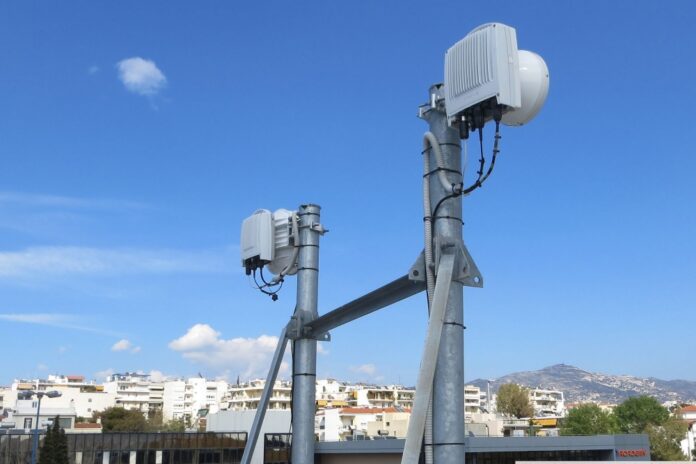Deutsche Telekom and Cosmote worked with Ericsson on a trial and test using higher frequency W-band as 5G backhaul for first time.
In trials at Deutsche Telekom’s Mobile Backhaul Service Centre in Cosmote’s headquarters in Athens (shown in picture, photo courtesy of Deutsche Telekom), the partners proved the viability of frequency bands beyond 100GHz, such as W-band, for multi-gigabit wireless backhaul capacities for 5G and 6G.
W-band sits in the electromagnetic spectrum range between 92-114GHz and is used for satellite communications, millimeter-wave radar research, military radar targeting and tracking applications, and some non-military applications.
Radio access networks are starting to use higher frequencies, such as 26GHz and 28GHz to allow more capacity, wireless backhaul is also looking into the possibility of higher frequencies with broader channels to enable greater bandwidth.
Wireless backhaul currently uses frequency bands from 4GHz to 80GHz to support 5G transport requirements.
Field trial
The joint field trial demonstrated for the first time a W-band wireless hop over a 1.5km range with telecom grade availability using pre-commercial equipment.
This W-band hop was installed parallel with a 1.5km E-band hop, to show that the W-band has a similar long-term performance to E-band (70/80GHz).
The trial recorded speeds of 5.7Gbps over the 1.5km distance and topped 10Gbps over 1km hops.
The result proved that W-band can perform on the same level as the E-band, which is currently the only frequency band supporting 10Gbps wireless backhaul capacities for 4G and 5G.
The W-band is expected to add more untapped spectrum needed for high-capacity wireless transport.
Access evolution
Dr. Konstantinos Chalkiotis, Vice President 5G Solutions, Access & Home Networks, Deutsche Telekom, says: “The evolution towards future-proof, cost-efficient and high-capacity wireless backhaul networks will play an important role to accommodate growing traffic demand, increased site location, including small and pico cells, and extend 5G services in the future.
“The results of our innovation trial with Ericsson confirm the feasibility of using higher frequency bands with wider channels as another solution in our portfolio to deliver high capacity and high performance backhaul for our customers in the 5G era. We hope soon to see those solutions brought into real production in a cost-efficient manner.”
Move towards 6G
Ericsson, Deutsche Telekom and Cosmote have a long history of joint innovation spanning 3G, 4G, 5G mobile and wireless backhaul networks, and has been researching technology for high-capacity radios above the 70/80GHz band for more than a decade.
Jonas Hansryd, Research Manager, Microwave Systems, Ericsson, says, “Two years ago, we showed for the first time the possibility to transport more than 100Gbps over a kilometer distance using millimeter wave bands.
In our latest joint project, we continue on that path showing the ability to evolve today’s wireless transport by supporting additional, high-capacity backhaul spectrum for 5G and future 6G.”



